| |
| |
|
Healey Duncan |
|
by Patrick Quinn |
|
|
| |
|
Big Duncan - Little
Duncan - Human Duncan |
|
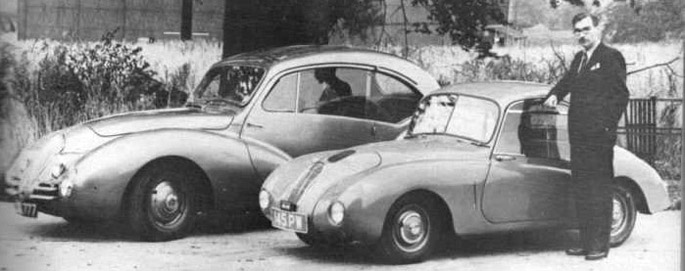
|
|
Healey Duncan Saloon -
Duncan Dragonfly - Ian Duncan |
|
|
| |
Some months back the US
Austin-Healey Magazine ran an article of mine about the original Warwick
built Healeys. Those 1,185 cars that were produced at the Donald Healey
Motor Company ‘s Warwick factory without any input from Austin from 1946
through to 1954. Yes it is sometimes forgotten that the DHMC were building
Healeys at the same time as the Austin-Healey was being built. Perhaps first
of all I should qualify what was actually built back then by the DHMC. To be
perfectly blunt the DHMC were assemblers of components brought in from
outside suppliers as about the only component of the early cars that was
produced in-house was the chassis. Everything else was manufactured
elsewhere either to the specifications of the DHMC or to the suppliers. |
|
| |
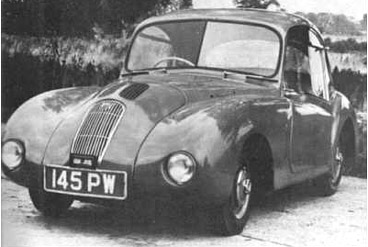 |
|
Duncan
Dragonfly |
|
The production of the
Nash-Healey is perhaps the most extreme example of the DHMC’s production
methods. The chassis was manufactured at Warwick and fitted with the
engine/gearbox came from Nash in the US. Then with the earlier cars it was
all transported to Coventry to have the body fitted and then returned to
Warwick to be completed before being shipped to the US. When Pininfarina
became involved it became even more circuitous as the whole
chassis/engine/gearbox or rolling chassis was shipped to Italy to have the
body fitted and then shipped to the US. No wonder the cars were so
expensive.
Anyway what I’m leading to
is that the |
|
| |
DHMC never made the body or
coachwork for the early Healey cars just complete rolling chassis that could
be fitted with coachwork to the buyer’s wishes. However certain
‘off-the-shelf’ bodies were offered and these complete cars became known by
the name of the Healey combined with that of the body manufacturer. Hence
the Healey Elliott, Healey Westland, Healey Tickford and Healey Abbott.
These models were all fitted with Riley engines and when other
engine/gearboxes were used they were known as the Nash-Healey and Alvis
Healey. There was also the Healey Silverstone and Healey Sportsmobile, both
also Riley powered and bodied away from the DHMC for the two extremes of
early post WW2 motoring with the Silverstone being a racing sports car and
the Sportsmobile offering the height of luxury. |
|
| |
Healeys production records
indicate that some 123 were sold purely as rolling chassis with a whole
range of different bodies fitted. Most were English and included saloons,
tourers and even station wagons or shooting breaks as the British like to
call them. The London coachbuilder Hobbs produced shooting breaks that
featured a heavy use of exterior timberwork not unlike the Woodies being
manufactured in the US at the time. There were a number of European
coachbuilders who also used the Healey chassis, such as the Swiss company
Beuttler with a number of highly fashionable open and closed bodies but once
again were very expensive.
For such a small
manufacturer the variations |
|
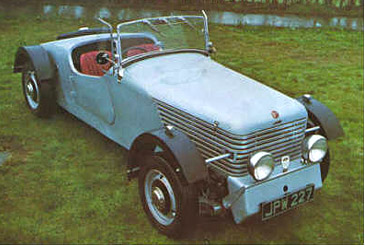 |
|
Healey
Duncan Drone |
|
|
| |
on offer from the DHMC were
really quite amazing and something to look back with a degree of respect.
However with Editor Greg’s indulgence I would to focus on just one of these
body manufacturers. A company that besides building bodies for Healeys and
other marques was also pushing the envelope of motor vehicle design. This
long gone company was known as Duncan Industries (Engineers) Ltd and if you
were to look through the Healey build records you will see that a total of
thirty-nine Healey chassis were clothed in Duncan bodies.
Now before we go on to the
Healey connection it’s worthwhile to have a look at Ian Duncan himself and
what else he was involved with, plus he does play a very small but important
role with the Austin-Healey some years later. |
|
| |
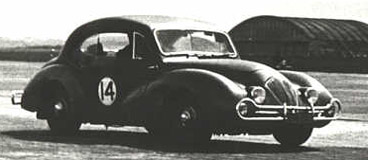 |
|
Healey Duncan racing at Ohakea
Circit New Zealand |
|
during 1948, now owned by
Patrick & Caroline Quinn |
|
Following the completion of
his mechanical engineering studies Ian Duncan went to work for the Bristol
Aeroplane Company who at the time were the largest single aircraft
manufacturer in the world. In 1940 with Europe at war he was promoted to the
position of chief technical assistant to Roy Fedden, the company’s chief
engineer. In 1942 Fedden left the company and travelled to the US to study
aero engine production methods on behalf of the British government with Ian
Duncan accompanying him. On their return they established Roy Fedden Ltd
with |
|
| |
a view of designing a new flat
six aero engine, a small gas turbine engine and the first Fedden car. |
|
| |
Given their experience with
radial aero engines it comes as no surprise that the eventual engine for the
new Fedden car was a rear mounted air-cooled three-cylinder radial driving
the rear wheels through a torque converter. The end result was a highly
advanced vehicle with chassis-less construction and rubber suspension.
Unfortunately the engine position way out the rear set up a highly
undesirable balance problem with the vehicle. During early testing the car
objected strongly to being driven with any enthusiasm and turned turtle by
flipping on to its roof. Work began on a replacement but there was a
distinct lack of enthusiasm.
Ian Duncan soon left the
company and commenced working with his brother’s canning machine company. By
the end of the war Duncan was established southwest of London in Norfolk
with his mind focused in producing his own car. Duncan Industries
(Engineers) Ltd was formed and ex Fedden staff like Frank Hamblin soon
joined. |
|
| |
Right from the start Duncan
had intentions on building a small car and it wasn’t long before the project
was given the name of Duncan Dragonfly. Both Duncan and Hamblin agreed that
while it was to be a small car, the Dragonfly was in reality to be a small
car in miniature and must be able to carry three persons. Strangely the team
first turned their minds to the wheel size as a small car had to have small
wheels and at the time small cars had 16 inch wheels which would have look
ridiculous. Ian Duncan promptly ordered five |
|
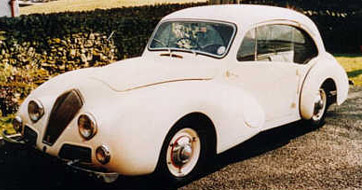
|
|
Healey Duncan in
England |
|
|
| |
12-inch wheels and tyres
from Crosley Motors of Cincinnati, USA. Eventually they turned to Dunlop who
offered to manufacture the wheels and tyres. |
|
| |
A number of engines were
considered for the Dragonfly with a BSA 500cc overhead valve air-cooled twin
decided upon. The team wanted front wheel drive and with the BSA powerplant
the gearbox was in unison with the engine. With the engine way forward of
the front wheels drive was via a chain driven differential and half shafts
complete with French designed Tracta constant velocity joints. Like the
Fedden the Duncan Dragonfly was also fitted with rubber suspension designed
by Alex Moulton. To students of automotive history this arrangement is quite
fascinating as it pre dates a far more famous ground breaking car by some
thirteen years. It wasn’t until 1959 when BMC introduced the new Mini that
was also front wheel drive with an engine and gearbox in unison, fitted with
constant velocity joints and Moulton designed rubber suspension.
It was important to Duncan
Industries that the Dragonfly was to be completed and driven on the road.
The end result was a perfect car in miniature weighing 1,064 lbs, 10ft 9 ½
in length, 4 ft 1 ½ tall and able to sit three abreast. It also had a
reasonable turn of speed being good for 65mph making other small engined
cars of the period look rather pedestrian.
Now don’t think that Duncan
industries were only involved in the construction of the prototype
Dragonfly. Yes it was a pet project of Ian Duncan but it didn’t put bread on
the table. The company needed cash to continue with the Dragonfly and it was
fortunate that the UK was starved for new motor vehicles. It may come as no
surprise that in the immediate post WW2 period the British motor
manufacturing industry was a particularly close net group with most major
players being in good relations with each other. Enter Donald Healey who was
a friend of Ian Duncan. |
|
| |
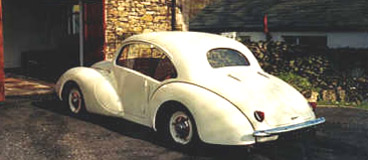 |
|
Other
Healey Duncan in England |
|
Healey chassis were
prefixed by letters with the A-type being the earliest and so on working up
to the G-type that were used in the Tickfords in 1954. Three A-type chassis
were ordered from the DHMC and the first one fitted with a Hillman Minx body
suitably modified to take the Healey kite shape grille. While that was
strange enough the next two were even more so with first a Ford Anglia
followed by a Prefect body being fitted. The next body was completely new
and fitted to |
|
| |
a Alvis TA14 chassis and it
was clear that the new design came from the same mind that designed the
Dragonfly body. Not a car in miniature but full size. As was common practice
of the time these limited production bodies were built using the coachbuilt
methods or aluminium panels attached to a timber frame. Interestingly the
timber frames were built by local boatbuilders. |
|
| |
So started a range of
Duncan bodied Healeys and Alvis cars which were in constant demand to those
who could afford the exorbitant prices. It turned out that Duncan Industries
were the first British coachbuilder that offered the same body to various
manufacturers and over time there were also Duncan bodied Daimlers, Bentleys
and Allard. They were also involved in general fabricating and continued to
manufacturer canning equipment.
Small British motor
manufacturers were hit a body blow in 1947 when the British government
increased purchase tax to 66 2/3 % on cars costing more than 1,000 Pounds.
This proved particularly difficult to Duncans but over a drink with James
Watt of the DHMC one evening, Ian Duncan came up with the answer. It was to
offer a very basic body on a Healey chassis for less that 1,000 Pounds where
even such things as the windscreen, passenger seat and spare tyre became an
optional extra. This car became known as the Duncan Drone and also
christened Spiv by some unkind souls. Owners were free to use their new car
as is or fit a brand new body to be then a second hand car and therefore
escape the hefty purchase tax.
The thirty-nine Duncan
bodied Healeys comprised of twenty-three saloons, one convertible and
fifteen drones. In total there were thirty Duncan bodied Alvis cars as well.
At the company’s peak Duncan Industries were employing close on to 120
people. |
|
| |
While the future looked rosy
for Ian Duncan it was the hefty 66 2/3 % purchase tax that was to sound the
death knell of his company. In the end Duncan Industries owed so much money
to the British Government that they had no choice but to sell off their
assets and close the doors. About the only tangible asset held by the
company was the Dragonfly, so Ian Duncan set about trying to interest
various vehicle manufacturers in the little car. Neither Jaguar or BSA were
interested but Ian Duncan approached Leonard Lord of Austin and he agreed to
buy the car for 10,000 Pounds providing that Duncan would also come and work
for him. |
|
| |
So both the Dragonfly and
Ian Duncan set off for Longbridge. At that stage Austin was not producing
any smaller cars so the Dragonfly created quite a bit of interest. It can’t
be said that the company was the most farsighted organisation and it wasn’t
long before all the innovative ideas were iron out and the result, the
Austin A30 while cute was strictly conventional.
Ian Duncan left Austin in
1951 when rumours of the merge with Morris were in the air. The |
|
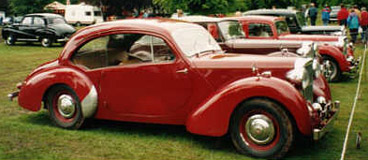 |
|
Alvis Duncan - See the
front is very different |
|
but the same from the
windscreen back |
|
|
| |
little Dragonfly had long
since been relegated to a storage area and was damaged to such an extent
that it was eventually cut up and sold for scrap.
After Austin Ian Duncan
stayed in the motor industry for a few years but then pursued his other
passion by starting a photographic business where he stayed until he
retired. During this time he remained friends with the Healey family and
took quite a bit of interest when the new Healey 100 was being designed.
While Geoff Healey was perplexed with the low geared four-speed gearbox
supplied by Austin limiting overall top speed. It was Ian Duncan who
suggested they could try the new Laycock de Normanville overdrive to provide
a higher top speed. |
|
| |
Tale of One Healey Duncan |
|
| |
Time has certainly taken
its toll on the Healey saloons, as it’s a fact of life that unless cared for
wood will warp, crack and rot. With their timber framed coachbuilt bodies
many Healeys were not destined to last which is sad, as they are extremely
quick and stylish motor cars. The Healey Silverstone is in a vastly
different situation as being alloy on a steel frame it has stood the test of
time.
Records indicate that of
the thirty-nine Healey Duncans produced, some eight still exist in various
states of repair. There is one Drone, one drop head coupe and six saloons. I
understand that the Drone is very much running as is two of the saloons and
the drop head coupe is coming to the end of a long restoration. The other
four saloons are in various states of decal depending on the owner’s
optimism. All are in the UK except for one of the saloons that’s in
Australia and lucky not have been scrapped many years ago. |
|
| |
Chassis number B1647 was
bought new in 1947 by a Mr Yelverston, a New Zealander working in England.
On a trip back to the antipodes in 1948 he bought the car with him via
Australia. On landing in New Zealand that Healey caused quite a stir amongst
the motoring fraternity as while most had heard of the new Healeys, but
having one in the country was something else again. Contemporary New Zealand
magazines featured this new English sporting saloon in which testers were
impressed at its speed.
Mr Yelverston returned to
the UK and left the Healey in the hands of Fred Sharman who with permission
raced the car in 1948 on airstrip circuit at Ohakea on New Zealand’s North
Island. It is not known how the car then ended back up in Sydney, Australia
a couple of years later. However it has recently found out that it was put
on consignment at the long defunct Neutral Motors in the Sydney suburb of
Double Bay. Sydneysiders would now laugh at the thought of a car dealer in
the genteel and well-to-do suburb of Double Bay.
The next mention of the
Healey was in 1956 when it was found looking rather forlorn and damaged in a
wrecking yard in Sydney’s western suburbs. Then over a period of five years
its chassis was rebuilt along with the engine, gearbox and suspension.
However it is assumed not completed as the vehicle |
|
| |
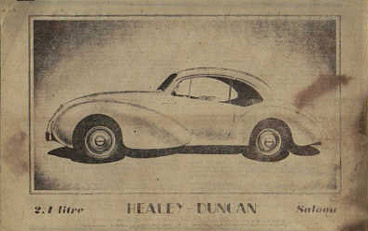 |
|
Part of
the Healey - Duncan Sales Brochure |
|
was advertised in 1961 for
345 Pounds in Australian Motor Sports as still slightly accident damaged.
The trail then goes cold
until 1977 when Healey and Austin-Healey enthusiast Keith Bagnall heard
about a strange Healey in the west of Sydney. Keith tracked it down and
subsequently bought it to keep his Healey Westland and Austin-Healey 100
company. Sadly Keith died last year but I had been a friend since the early
1970s and we would often chat about the local Healey scene. On the very day
he brought the Duncan home I asked him for first refusal should he ever
decided to part with it – he agreed. |
|
| |
It took some time and a
number of reminders but in 1987 Keith asked if I was still interested in the
Duncan. I didn’t have to think too long about it and luckily we were flushed
with funds at the time following the death of an aunt.
So the Healey Duncan was
now mine and safely tucked up next to the BN3/1. I would be fantasizing to
say that was in anywhere near going condition as I suspect that it hasn’t
run under its own power for close to fifty years. It wasn’t the easiest car
to move when we moved into the mountains west of Sydney in 1992 and it now
sits patiently waiting its turn after various pergolas, fountains, extra
bedrooms and the like. However I have tracked down quite a bit of the car’s
history and definitely become immersed in the history of the DHMC and its
products, both Healey and Austin-Healey.
There are pieces missing,
the engine to be rebuilt and so on. Plus I have to find the knowledge of
what goes where. However it is part of the amazing history of the DHMC and
something I am passionately interested in. So let’s see where we go.
|
|
| |
Our thanks
to Patrick Quinn for the use of his article on Ian Duncan |
|
|
|








